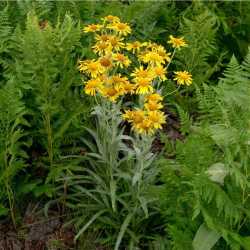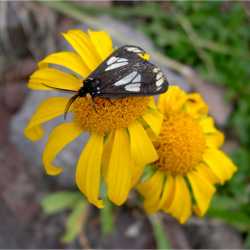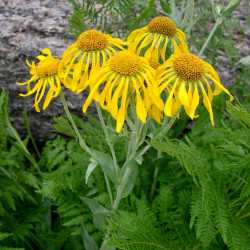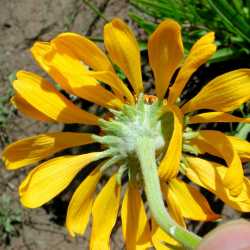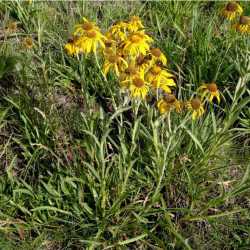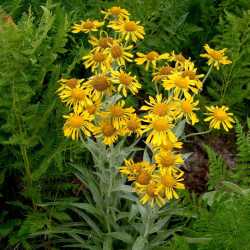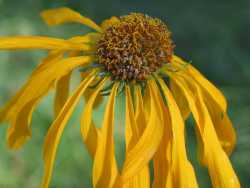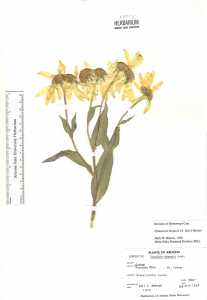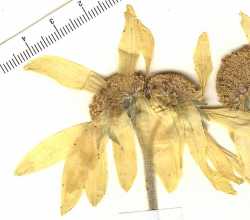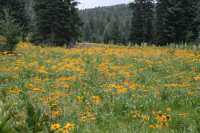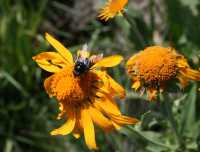Perennials, 30-100 cm (polycarpic, often with blackish, stout rhizomes). Stems 1-4, green throughout to often purple-red-tinted proximally to purple-red-tinted throughout, branched distally, glabrous or ± hairy. Leaves: blades simple, glabrous or ± hairy, gland-dotted; mid leaves simple. Heads 1-12 per plant, in paniculiform to corymbiform arrays. Peduncles 3-16 cm, ± hairy, tomentose distally near involucres. Involucres hemispheric to broadly campanulate, 12-17 × 19-26 mm. Phyllaries in 2 series, subequal; outer 16-24, basally connate 1/4-1/3 their lengths, ovate to lanceolate, 11-16 mm, apices acute; inner 20-26, obovate to elliptic, 7.5-8.5 mm, apices acuminate to acute. Ray florets 14-26; corollas usually yellow-orange to orange, 21-45 × 4.2-8.5 mm. Disc florets 100-325+; corollas 4.2-5.4 mm. Cypselae obpyramidal to narrowly obpyramidal, 3.5-4.5 mm; pappi of 5-7 lanceolate to lanceolate-acuminate scales 2.9-4.1 mm. 2n = 30.
Flowering (May-)Jul-Aug(-Nov). Mountain meadows, open forests, along streams; 1500-3700 m; Ariz., Calif., Colo., Idaho, Nev., N.Mex., Oreg., Utah, Wyo.
Duration: Perennial
Nativity: Native
Lifeform: Forb/Herb
General: Herbaceous perennials, to 100 cm tall, stems 1-4, green throughout to often purple-red-tinted proximally to purple-red-tinted throughout, branched distally, herbage subtomentose when young, glabrate later, often with blackish, stout rhizomes.
Leaves: Alternate, oblanceolate, becoming lanceolate to ovate distally, the leaves winged petioled, not decurrent, gland-dotted, faces glabrous-hairy.
Flowers: Heads large and showy, radiate, the rays yellow to orange, 15-30 mm long, disk flowers yellow, involucres hemispheric to broadly campanulate, 7-10 mm, phyllaries in 2 series, these rigid, subequal; the outer 16-24, ovate to lanceolate, 11-16 mm, the inner 20-26, obovate to elliptic, 7.5-8.5 mm, the heads 1-12, borne in paniculiform to corymbiform arrays.
Fruits: Achenes turbinate, 8-10 ribbed. Pappi of 5-7 lanceolate to lanceolate-acuminate scales, these 2-3 mm long.
Ecology: Found in rich soils in coniferous forests, along streams, and in mountain meadows, from 7,000-11,000 ft (2134-3353 m); flowering June-September.
Distribution: Wyoming to Oregon, south to New Mexico, Arizona, and California.
Notes: Look for this species under Helenium hoopesii in older texts. Good identifiers for this species are the leaves which are not decurrent, a common trait in this genus, the linear, spreading, persistent rays, and the subtomentose young plants.
Ethnobotany: A snuff of the crushed blossoms were used to treat hay fever and headaches, the plant was used to inhibit vomiting, and the roots were used as chewing gum. The crushed flowers were boiled with juniper ash and used as a yellow dye.
Etymology: Hymenoxys comes from Greek hymen, meaning membrane, and oxys, meaning sharp or sharp pointed, while hoopesii is named for Thomas Hoopes (1834-1925) an entrepreneur who collected for Asa Gray.
Synonyms: Helenium hoopesii, Dugaldia hoopesii
Editor: SBuckley 2010



